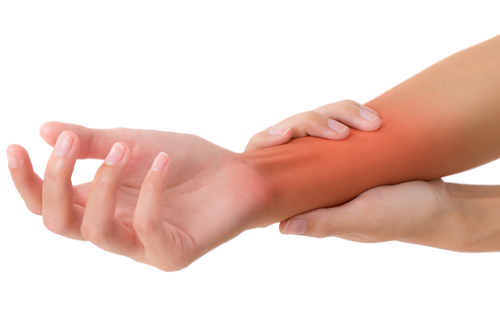DIAGNOSIS
Tendinitis can usually be diagnosed during the physical exam alone. Your doctor may order X-rays or other imaging tests if he or she needs to rule out other conditions that may be causing your signs and symptoms.
TREATMENTS
The goals of tendinitis treatment are to relieve your pain and reduce inflammation. Often, taking care of tendinitis on your own — including rest, ice and over-the-counter pain relievers — may be all the treatment that you need.
Medications
For tendinitis, your doctor may recommend these medications:
- Pain relievers. Taking aspirin, naproxen sodium (Aleve) or ibuprofen (Advil, Motrin IB, others) may relieve discomfort associated with tendinitis.
Topical creams with anti-inflammatory medication also may be effective in relieving pain without the potential side effects of taking anti-inflammatory medications by mouth.
- Corticosteroids. Sometimes your doctor may inject a corticosteroid medication around a tendon to relieve tendinitis. Injections of cortisone reduce inflammation and can help ease pain.
Corticosteroids are not recommended for chronic tendinitis (lasting over three months), as repeated injections may weaken a tendon and increase your risk of rupturing the tendon.
- Platelet-rich plasma (PRP). PRP treatment involves taking a sample of your own blood and spinning the blood to separate out the platelets and healing factors. The solution is then re-injected into the area of chronic tendon irritation.
Though still under investigation, PRP injection in the region of chronic tendon irritation has been shown to be beneficial for many chronic tendon conditions
Therapy
You might benefit from a program of specific exercise designed to stretch and strengthen the affected muscle-tendon unit. For instance, eccentric strengthening — which emphasizes contraction of a muscle while it’s lengthening — has been shown to be effective in treating chronic tendon inflammation.
Surgical and other procedures
Depending on the severity of your tendon injury, surgical repair may be needed, especially if the tendon has torn away from the bone.
For chronic tendon inflammation, focused aspiration of scar tissue (FAST) is a minimally invasive treatment option using ultrasound guidance and very small instruments designed to remove tendon scar tissue without disturbing the surrounding healthy tendon tissue.
FAST achieves the same goal as open surgery but is performed under local anesthesia in a nonsurgical setting. Most people return to normal activities within one to two months.
Lifestyle and home remedies
To treat tendinitis at home, R.I.C.E. is the acronym to remember — rest, ice, compression and elevation. This treatment can help speed your recovery and help prevent further problems.
- Rest. Avoid activities that increase the pain or swelling. Don’t try to work or play through the pain. Rest is essential to tissue healing. But it doesn’t mean complete bed rest. You can do other activities and exercises that don’t stress the injured tendon. Swimming and water exercise may be well-tolerated.
- Ice. To decrease pain, muscle spasm and swelling, apply ice to the injured area for up to 20 minutes several times a day. Ice packs, ice massage or slush baths with ice and water all can help. For an ice massage, freeze a plastic foam cup full of water so that you can hold the cup while applying the ice directly to the skin.
- Compression. Because swelling can result in loss of motion in an injured joint, compress the area until the swelling has ceased. Wraps or compressive elastic bandages are best.
- Elevation. If tendinitis affects your knee, raise the affected leg above the level of your heart to reduce swelling.
Although rest is a key part of treating tendinitis, prolonged inactivity can cause stiffness in your joints. After a few days of completely resting the injured area, gently move it through its full range of motion to maintain joint flexibility.
You can also try over-the-counter medications — such as aspirin, ibuprofen (Advil, Motrin IB, others), naproxen sodium (Aleve) or acetaminophen (Tylenol, others) — in an attempt to reduce the discomfort associated with tendinitis.


